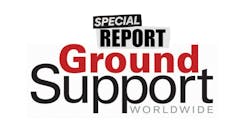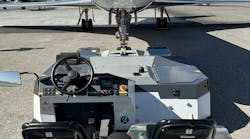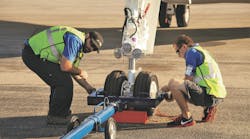Special Report
The Ins & Outs of Charter Taxes
NATA-sponsored session provides operators with guidance, clarification
By Jodi Richards, Associate Editor
July 2004
LAS VEGAS — A seminar designed specifically for Part135 operators was held in conjunction with the National Air TransportationAssociation’s annual meeting held here in May. Led by Nel Sanders-Stubbs,partner, Conklin & de Decker Aviation Consultants, the sessionoffered guidance and clarification for charter operators. Following is a sampling from the session.
Jacqueline Rosser, NATA manager of flight operations, and Eileen Gleimer, Crowell& Moring LLP, also presented during the day-long seminar.
According to Sanders-Stubbs, one of the most confusing aspects of a charter operation can be taxes, particularly because the FAA and IRS do not define commercial aviation in the same manner. The IRS does not consider the FAA’s definition of a commercial operator determinative in deciding which tax applies. While the FAA looks at who has operational control of the aircraft, IRS looks at who has possession, command, and control. This is important to keep in mind when determining if the commercial tax applies to a particular flight, explains Sanders-Stubbs.
Federal excise tax (FET) is a federal sales tax imposed on aviation, says Sanders-Stubbs. There are three different FETs, including noncommercial aviation, domestic commercial aviation, and international commercial aviation. “You are almost always subject to one of the FETs,” she says.
The noncommercial aviation FET is a fuel tax that operators do not normally see. Jet fuel is currently taxed at 21.9 cents per gallon, while avgas is 19.4 cents per gallon.
The domestic commercial aviation FET applies to the transportation of persons and property. In regard to persons, the tax is 7.5 percent of the amounts paid and a segment fee. If it is the transportation of property, the FET is 6.25 percent.
The segment fee for 2004 is $3.10 per person, per leg. However, flights into rural airports are not subject to segment fees, says Sanders-Stubbs. A rural airport is defined as any airport that has less than 100,000 enplanements per year and is located more than 75 miles away from an airport that has at least 100,000 annual enplanements.
International commercial aviation FET rates are as follows: $13.70 international (per person); $6.90 Hawaii and Alaska (departures only). An uninterrupted trip, such as one that takes off from Arizona, stops for fuel in Miami, and then arrives in the Bahamas, explains Sanders-Stubbs, is not subject to domestic commercial FET. “If you’re on the ground for more than 12 hours you owe domestic tax on the first leg, and international tax on the second.”
Who/What Is FET-Exempt?
When it comes to what or who is — or is not — exempt from
FET, San-ders-Stubbs offers the following list:
- Not subject to commercial tax: catering (when separately stated); limousine service for the customer; flight phones for the customer; things that the customer can/could do for him or herself.
- Taxable items include: layover time; waiting time; crew expenses; landing fees; state taxes; and other taxes and fees. “If you’re charging them [charter customers] for it, it’s taxable,” says Sanders-Stubbs.> The last thing you do when figuring taxes is apply the FET, stresses Sanders-Stubbs.
There are some exemptions from commercial taxes. They include: small aircraft weighing less than 6,000 pounds; helicopters used in the exploration or development of hard minerals, oil or gas, or forestry operations; and emergency medical flights.
She clarifies, “If a flight is scheduled to transfer a patient, it’s probably not an emergency.” Obtaining a note from the physician stating that it is an emergency is good to have in case of an IRS audit. Transportation of an organ is considered transportation of property and falls under those FET guidelines.
Sanders-Stubbs says confusion arises when operators don’t understand how the exemption works or how narrow it is. Even if the aircraft is less than 6,000 pounds, it is subject to FET if it is following an established route.
Commercial FET applies to demo flights, state taxes, layover time and expenses of crew, flight training (if they are employees of someone else), landing and parking fees.
FETs on demonstration flights can be avoided, says Sanders-Stubbs, if the charges for the flight are applied after the aircraft is purchased.
“All these rules are for the airlines,” says Sanders-Stubbs. “DOT is trying to apply these rules to air charter.”
For brokered flights, she offers the following example for calculating the FET: For a $1,000 charter, if the broker charges $1,100, FET is due on the full amount. If the broker charges $1,000 for the flight, and $100 for the commission is separately stated, FET is only due on $1,000. The operator who carries the passenger is generally responsible for collecting and remitting the FET.
IRS Audit: What To Expect
According to Sanders-Stubbs, the IRS feels there is a high degree of
noncompliance within the air charter and business aviation community.
Primarily, she says, this is because agents don’t understand
general aviation and, typically, rulings are written for the airlines.
There are several ways operations can be flagged for an audit, according to Sanders-Stubbs. They include: referral from income tax examiner; examination of tax documents; claims for refunds; complaint from an unhappy customer; airport registers; invoices; advertisements; and examinations of other taxpayers (somebody you have a business relationship with got audited).
In advance of the audit, the taxpayer will receive a letter from the IRS and/or a questionnaire. “They don’t just show up on your doorstep,” says Sanders-Stubbs.
IRS auditors will ask for a variety of documents. Sanders-Stubbs advises that the following be readily available: excise/income tax returns; source date for Form 720, aircraft logs; accounting ledgers; insurance policy (who is named, what is covered); FAA bill of sale; and aircraft agreements (all management and operation control agreements).
Adds Sanders-Stubbs, “The IRS does not understand the mix of 91 and 135. They will assume everything is FET-able. It’s your job to prove it’s not.”
During an audit, the IRS will review a charter company to determine the type of services provided, create a list of aircraft owned and provided by the charter company, review logs looking for untaxed flights, as well as ask to see any lease agreements.
For active Form 720 filers, the statute of limitations for the IRS is three years. However, if the company is not an active filer, IRS auditors can go back as far as they want, says Sanders-Stubbs. Another tip: if you have a blank line on a form, write N/A or cross through it to clarify that it was not overlooked.
When dealing with the IRS, Sanders-Stubbs recommends providing the auditor all the materials requested, but one is not required to volunteer any information. The audited company also has the right to ask questions. “Have them explain it so you understand it,” she says. “Don’t be intimidated.”
Most importantly, Sanders-Stubbs recommends businesses assume they will be audited at some point and to be prepared. “Document everything and get signatures.”
For Information...
For details on charter tax or other seminars sponsored by the National Air Transportation Association and/or Conklin & de Decker, visit www.nata.aero or www.conklindd.com.




